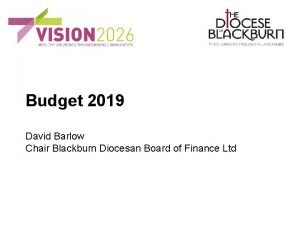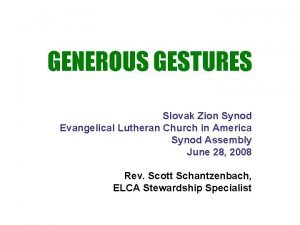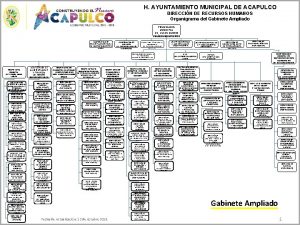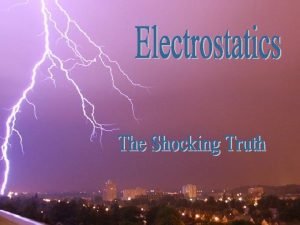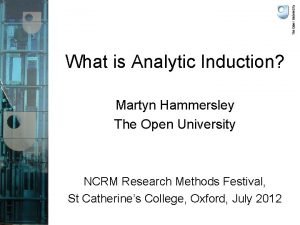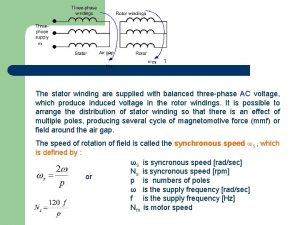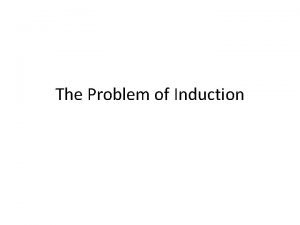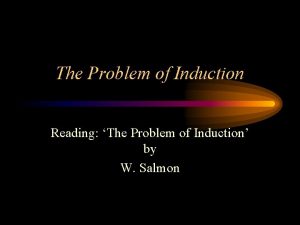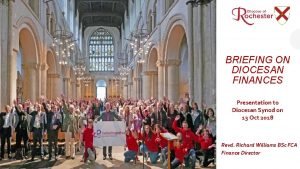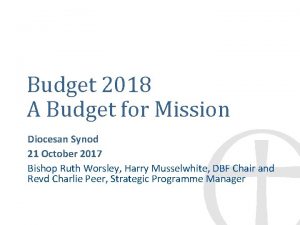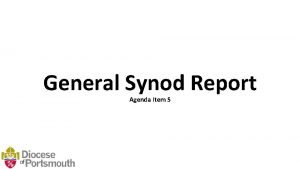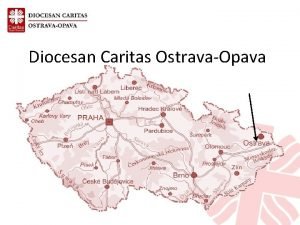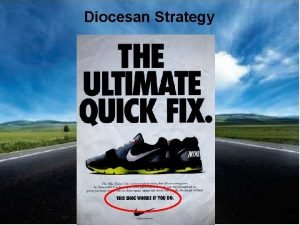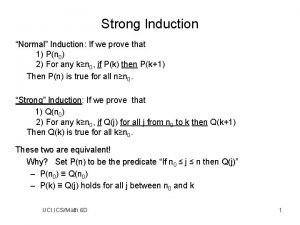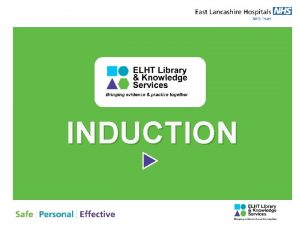INDUCTION SESSION DIOCESAN SYNOD 2018 2021 Composition of













- Slides: 13

INDUCTION SESSION DIOCESAN SYNOD 2018 - 2021

Composition of Diocesan Synod • 3 Houses (Laity, Clergy and Bishops) • Diocesan Bishop is the President of Synod • The Chair of the House of Clergy and the Chair of the House of Laity are Vice. Presidents of Synod. • Meetings of the full Synod (all 3 Houses meeting together) are normally chaired by the President in conjunction with the Vice Presidents.

Composition (2) • All full members of Synod are members of one of the Houses. The Houses of Clergy and Laity have approximately the same number of members. • The Houses also meet separately on a variety of occasions (including today) • Synod meetings are normally held in public • Observers from other denominations are invited to be present

Members • 4 different categories of membership – – Ex officio (approximately 20) Elected deanery representatives (up to 118) Bishop’s nominees (a maximum of 10) Co-options (a maximum of 10) • Elected members are in the majority by a considerable margin. • Although constrained in certain ways, the will of Synod is often determined by the will of the elected members.

Officers • The Registrar: Alison Stock • The Secretary of Synod: Stephen Hancock (also the Diocesan Secretary) • Synod Office staff: Ed Moffatt, Sara Ashton and Hannah Cross (all part time) • Director of Communications: vacancy • Director of Finance: Neil Williams

What does Synod do? The Synodical Government Measure states in Section 4 (2) that the functions of the diocesan synod shall be: “a) to consider matters concerning the Church of England to make provision for such matters in relation to their diocese, and to consider and express their opinion on any other matters of religious or public interest b) to advise the bishop on any matters on which he may consult the synod; c) to consider and express their opinion on any matters referred to them by the General Synod and in particular to approve or disapprove provisions referred to them by the General Synod under Article 8 of the constitution. ” It also says in 4 (3) “It shall be the duty of the bishop to consult with the diocesan synod on matters of general concern and importance to the diocese”.

How does Synod work? Church Representation Rule 34: Procedure of Diocesan Synods 34. (1) The diocesan synod shall make standing orders which shall provide (a) that the bishop need not be chairman of its meetings if and to the extent that standing orders otherwise provide; (b) that there shall be a secretary of the diocesan synod; (c) that a specified minimum number of meetings being not less than two shall be held in each year; (d) that a meeting of the diocesan synod shall be held if not less than a specified number of members of the synod so request; (e) that subject to the three next following sub-paragraphs, nothing shall be deemed to have the assent of the diocesan synod unless the three houses which constitute the synod have assented thereto but that if in the case of a particular question (except a matter referred to the diocesan synod by the General Synod under the provisions of Article 8 of the Constitution) the diocesan bishop (if present) so directs, that question shall be deemed to have the assent of the house of bishops only if the majority of the members of that house who assent thereto includes the diocesan bishop; (f) that questions relating only to the conduct of business shall be decided by the votes of all the members of the diocesan synod present and voting; (g) that every other question shall be decided by the votes of all the members of the diocesan synod present and voting, the assent of the three houses being presumed, unless the diocesan bishop (if present) requires or any ten members require that a separate vote of each house be taken;

Church Representation Rule 34 (cont): (h) that if the votes of the houses of clergy and laity are in favour of any matter referred to the diocesan synod by the General Synod under the provisions of Article 8 of Schedule 2 of this Measure that matter shall be deemed to have been approved for the purposes of the said Article; (i) that where there is an equal division of votes in the house of bishops, the diocesan bishop shall have a second or casting vote; (j) that the diocesan bishop shall have a right to require that his opinion on any question shall be recorded in the minutes; (k) that there shall be a bishop's council and standing committee of the diocesan synod with such membership as may be provided by standing orders and with the functions exercisable by it under section 4(4) of the Measure and such other functions as may be provided by the standing orders or by these rules or by any Measure or Canon; and may contain such further provisions consistent with these rules as the diocesan synod shall consider appropriate. (2) No person shall be entitled to serve as a member of more than one bishop's council and standing committee at the same time. (3) The registrar of the diocese shall be the registrar of the diocesan synod, and may appoint a deputy.

Government by Relationship • • Deanery Synods General Synod (currently 8 representatives) Diocesan Board of Finance Bishop’s Diocesan Council – Bishop’s Council and Standing Committee – Board of Directors of the Diocesan Board of Finance – Diocesan Mission and Pastoral Committee

Government by Relationship (2) • Diocesan Board of Education • Archidiaconal Mission and Pastoral Committees • Assets Group (which carries out the work of the Glebe and Parsonages Committees, among other things) • Diocesan Advisory Committee for the Care of Churches

Effective Membership • Get to know other members! • Preparation, listening and speaking and courteous disagreement. • Responsibility for decisions • Communication to and from Deanery Synods and parishes • Electoral participation (as voters and candidates)

Rules of Engagement • Church Representation Rule 34: Procedure of Diocesan Synods • Standing Orders of Diocesan Synod • Informality where possible – Suspension of Standing Orders (SOs 3 and 59) • Speaking (SO 30) and debate (SOs 28 – 42) • Asking questions (SOs 26, 69 - 71) • Motions and amendments (SOs 26, 27 and 43 49) • Agenda and minutes (SOs 18 and 20)

Miscellaneous • Church Representation Rules (Church House Publishing, www. chpublishing. co. uk ISBN: 9780715111062 or online at https: //www. churchofengland. org/more/policy-andthinking/church-representation-rules) • Mentors: arranged via Houses of Clergy and Laity • Website: https: //exeter. anglican. org/who-we-are/synod/ • Synod Office contact details: tel. 01392 294931, synod@exeter. anglican. org • Ed Moffatt: tel. 01392 294928 ed. moffatt@exeter. anglican. org
 Blackburn diocesan board of finance
Blackburn diocesan board of finance Synod of the pacific
Synod of the pacific Slovak zion synod
Slovak zion synod Que letra continua m v t m j
Que letra continua m v t m j Strategic plan 2018 to 2021
Strategic plan 2018 to 2021 Directorio del h ayuntamiento de acapulco 2018 2021
Directorio del h ayuntamiento de acapulco 2018 2021 Type of charging processes
Type of charging processes What is analytic induction
What is analytic induction Pre heat tunnel
Pre heat tunnel How to test a 3 phase motor
How to test a 3 phase motor Air gap power in induction motor formula
Air gap power in induction motor formula Problem of induction example
Problem of induction example Problem of induction example
Problem of induction example Power flow diagram of an induction motor
Power flow diagram of an induction motor
